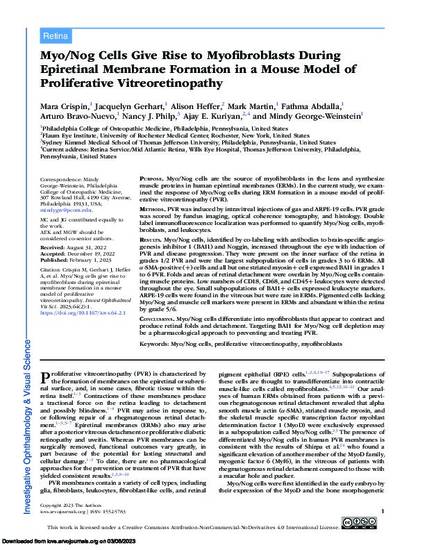
PURPOSE: Myo/Nog cells are the source of myofibroblasts in the lens and synthesize muscle proteins in human epiretinal membranes (ERMs). In the current study, we examined the response of Myo/Nog cells during ERM formation in a mouse model of proliferative vitreoretinopathy (PVR).
METHODS: PVR was induced by intravitreal injections of gas and ARPE-19 cells. PVR grade was scored by fundus imaging, optical coherence tomography, and histology. Double label immunofluorescence localization was performed to quantify Myo/Nog cells, myofibroblasts, and leukocytes.
RESULTS: Myo/Nog cells, identified by co-labeling with antibodies to brain-specific angiogenesis inhibitor 1 (BAI1) and Noggin, increased throughout the eye with induction of PVR and disease progression. They were present on the inner surface of the retina in grades 1/2 PVR and were the largest subpopulation of cells in grades 3 to 6 ERMs. All α-SMA-positive (+) cells and all but one striated myosin+ cell expressed BAI1 in grades 1 to 6 PVR. Folds and areas of retinal detachment were overlain by Myo/Nog cells containing muscle proteins. Low numbers of CD18, CD68, and CD45+ leukocytes were detected throughout the eye. Small subpopulations of BAI1+ cells expressed leukocyte markers. ARPE-19 cells were found in the vitreous but were rare in ERMs. Pigmented cells lacking Myo/Nog and muscle cell markers were present in ERMs and abundant within the retina by grade 5/6.
CONCLUSIONS: Myo/Nog cells differentiate into myofibroblasts that appear to contract and produce retinal folds and detachment. Targeting BAI1 for Myo/Nog cell depletion may be a pharmacological approach to preventing and treating PVR.
Available at: http://works.bepress.com/arturo-bravo-nuevo/71/

This article was published as the cover article in Investigative Ophthalmology and Visual Science, Volume 64, Issue 2.
The published version is available at https://doi.org/10.1167/iovs.64.2.1.
Copyright © 2023 The Authors. CC BY-NC-ND 4.0.